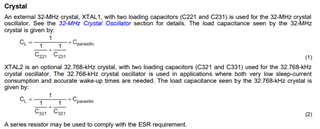Tool/software:
Dear sir,
Could you let me know the Crystal oscillator pin capacitance(Pin 22&23 and pin 32&33) of CC2530?
The CC2530 EVM board uses load capacitance of 12.5pF for 32.768KHz and the external capacitor connected is 15pF. To reach load capacitance of 12.5pF, there must be 10pF leftover on the oscillation pin respectively (let us ignore PCB trace parasitic capacitance at this moment).
And for 32MHz crystal oscillator, CC2530 EVM board selects load capacitance of 16pF and the external capacitor connected is 27pF. To reach load capacitance of 16pF, there must be 5pF leftover on the oscillation pin respectively (let us ignore PCB trace parasitic capacitance at this moment).
Normally the oscillation pin capacitance of the MCU is in the range of 2~3pF, I can not imagine the Cpin can reach about 10pF. That is why I ask the pin capacitance of Pin 22&23 and pin 32&33 of CC2530.
Thanks
John




